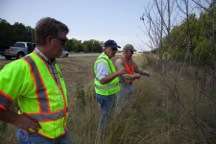
To learn more about solutions to vegetation management that meet safety challenges, I spoke with several roadside management specialists. Here are some of the strategies they’re using to protect their crews and motorists.
Spend Less Time on Roadways
High traffic volumes can make maintaining roadways a dangerous job, says Bill Nantt, landscape specialist, California Department of Transportation. His team’s roadside maintenance program includes a preemergence herbicide application followed by mowing and a touch-up herbicide application later in the season where needed.
By keeping roadside weeds under control, Nantt’s crews spend less time near busy highways. “The fewer herbicide applications and mowings we make, the safer it is for everyone,” he says.
Chip Rosan, roadside environmental administrator, Delaware Department of Transportation, also believes less time spent near traffic is important for crew safety. “Strategic herbicide applications help us minimize crew time on roadsides,” he says. “Applying herbicides takes less time and equipment, and reduces follow-up compared to mowing alone.”
Reduce Fire Danger
Drought conditions in California have made roadside fire management even more important. Nantt’s crews maintain a 4- to 8-foot bareground fire strip along shoulder areas for fire control. Adjacent to the fire strip, crews mow or apply a selective herbicide for broadleaf control. Both programs leave some vegetation in place as a rainwater biofilter.
“Mowing is twice as expensive as chemical control,” says Nantt. “And mowing next to the pavement doesn’t mitigate fire danger. A cigarette can start a fire in just four inches of vegetation. While it may burn slowly, the fire will eventually move to taller weeds and pick up momentum. Mowing can also cause fires.”
Keep Sightlines Open
For Brian O’Neill, president of Weeds, Incorporated, in Aston, Pennsylvania, including herbicide use in his roadside maintenance contracts solves safety issues and boosts crew productivity.
 In Delaware, Chip Rosan (left) and Brian O’Neill (right) work closely with their DuPont representative Mark Rice to find the right weed-control programs to match local challenges.
In Delaware, Chip Rosan (left) and Brian O’Neill (right) work closely with their DuPont representative Mark Rice to find the right weed-control programs to match local challenges.“My company covers three-quarters of Delaware for the state’s department of transportation,” O’Neill says. “We concentrate on keeping sightlines open and roadsides safe. Motorists don’t want to pull off a road shoulder and crash into guardrails because they can’t see them. Keeping weeds controlled around and under guardrails also allows water to flow off roadways for less vehicle hydroplaning.”
To meet DOT maintenance goals, O’Neill has been using selective weed control on roadsides where erosion control is needed, and bareground control around guardrails.
“We’ve received excellent preemergence and postemergence control of a broad spectrum of annual and perennial weeds with DuPont™ Perspective®herbicide,” O’Neill notes. Since the product has a low use rate, “We’ve gone from applying gallons of active ingredient per acre to ounces per acre with Perspective®. That means our trucks can take longer trips, with fewer containers to handle.”
For more ideas on maintaining roadside safety for the public and crews, visit landmanagement.dupont.com.
About the author: Dan Zapotok is the portfolio manager for DuPont Land Management, where he is responsible for products within the vegetation management, railroad and forestry markets. Zapotok has worked with DuPont for more than 20 years, holding positions in operations, project management and marketing. He has a bachelor’s degree from Pennsylvania State University.













